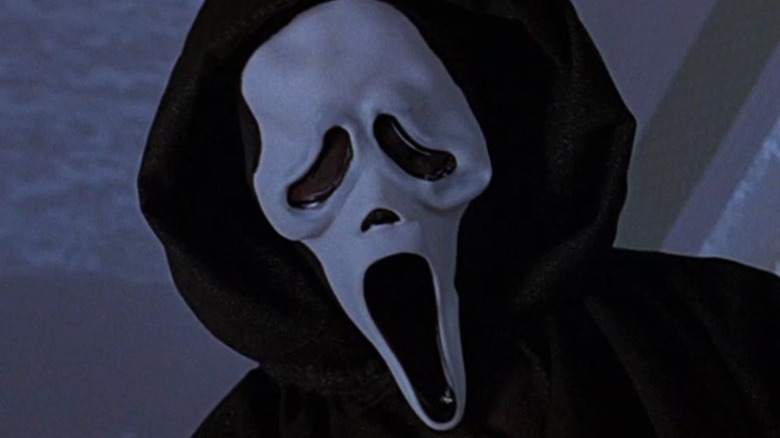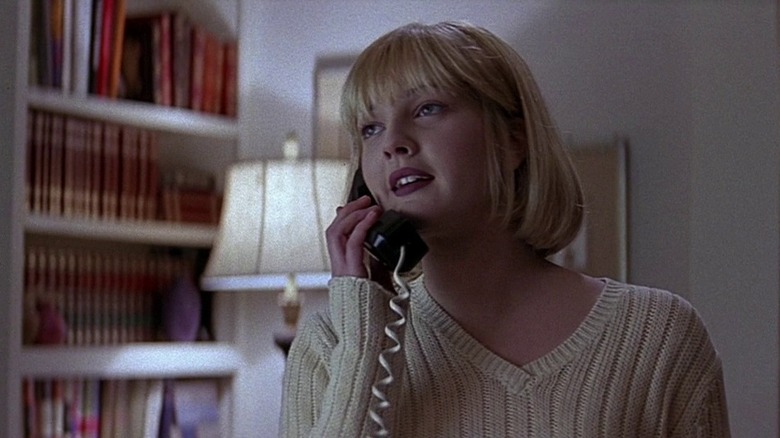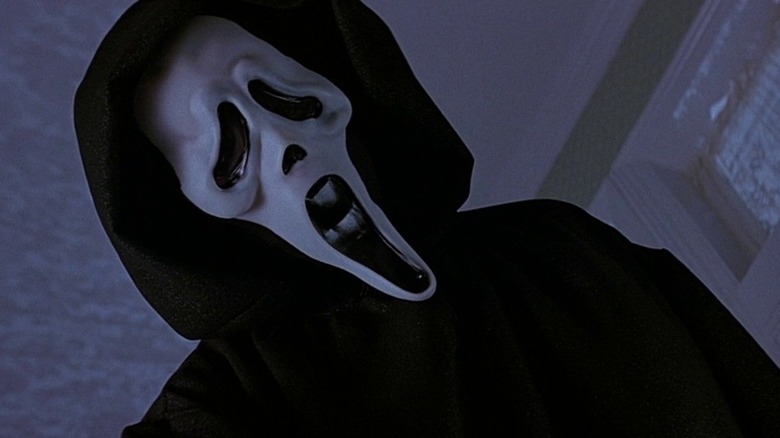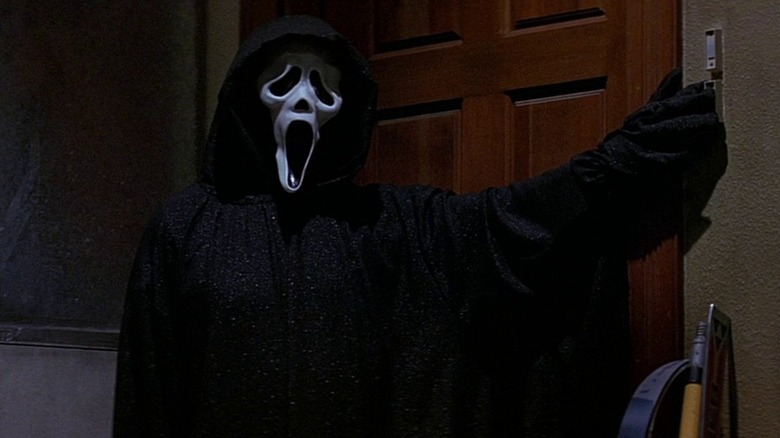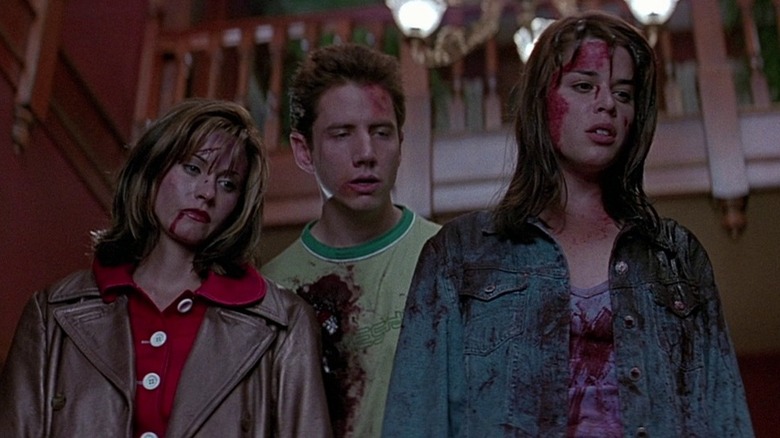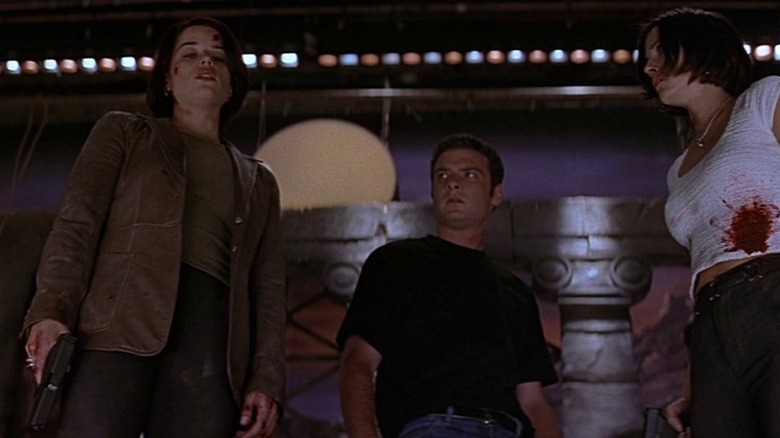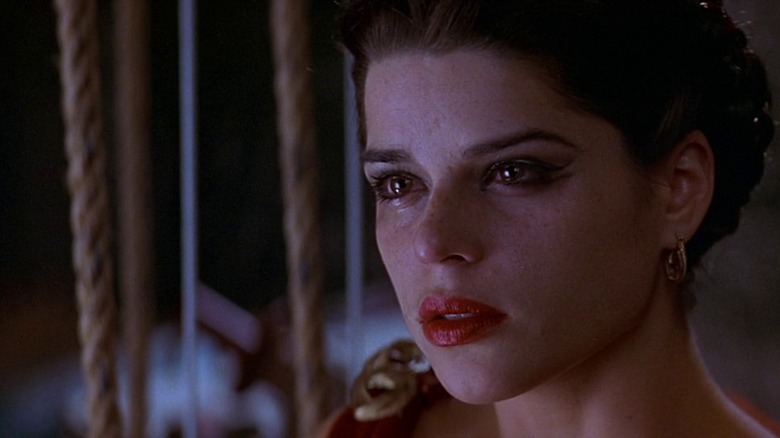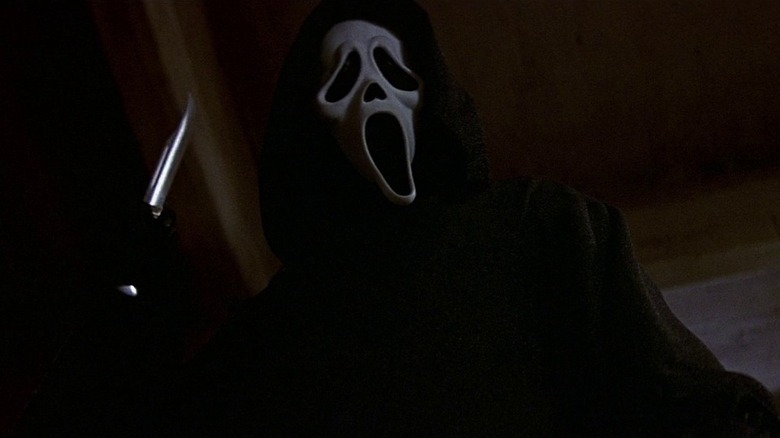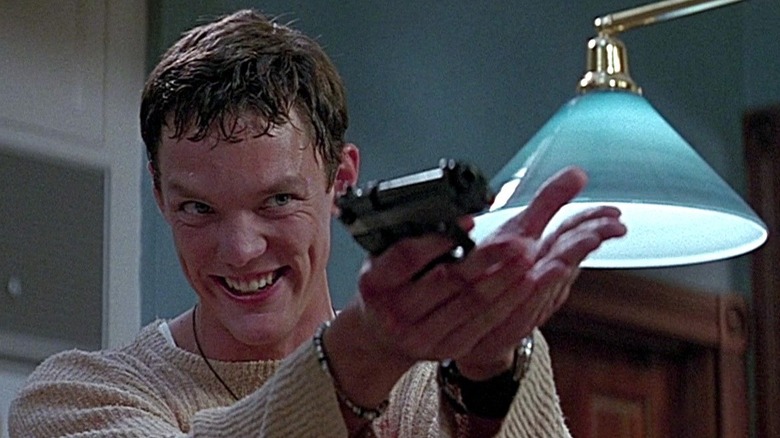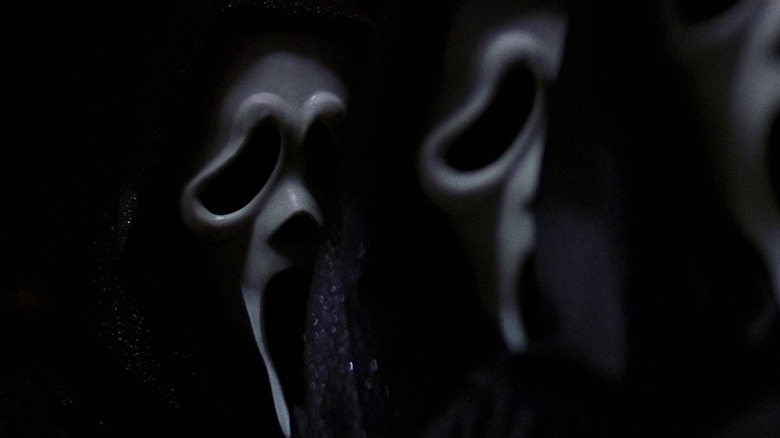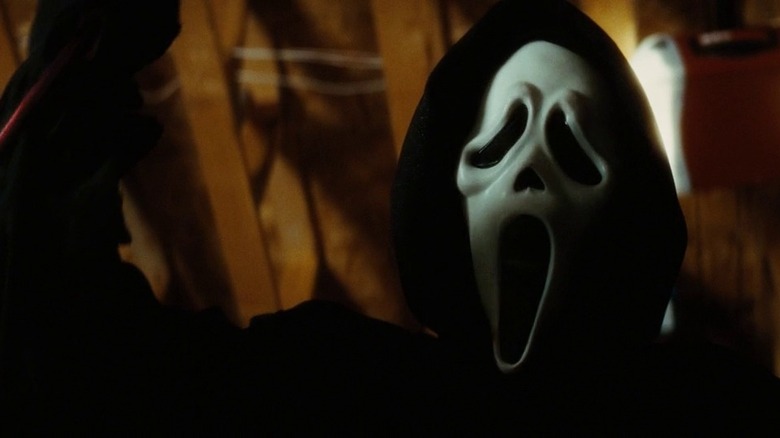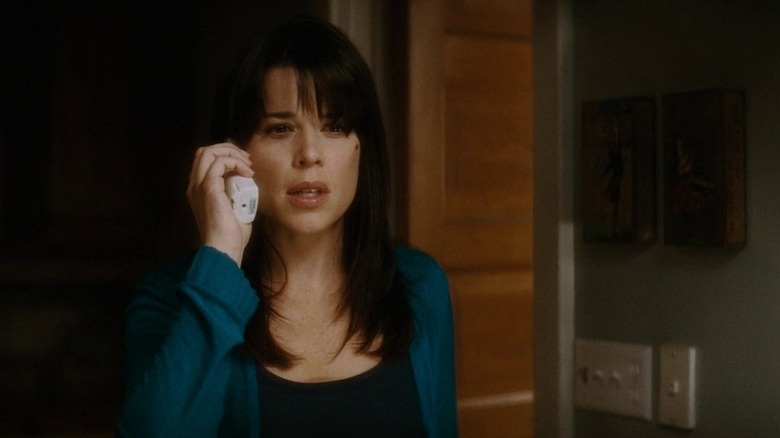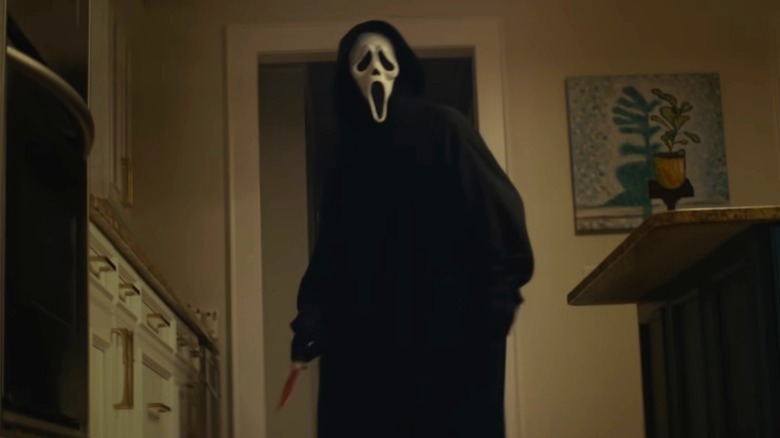The Untold Truth Of Scream
Do you like scary movies? Even if they're not your cup of tea, "Scream" may prove to be the exception. This 1996 feature from director Wes Craven is one of the greatest horror titles of all time, with its genre-savvy approach to horror storytelling still leaving ripple effects on this domain of cinema to this very day. The original "Scream" proved so enormously popular that it managed to spawn a quartet of sequels and a TV series, resulting in a mega-prominent franchise that's spanned decades. With multiple generations now accustomed to the vibes and thrills of "Scream," it can be easy to assume that, unlike the initial identity of the killer in a "Scream" movie, you may know all there is to know about this particular horror saga.
In reality, though, even the most ardent devotees to the exploits of Sidney Prescott and friends won't know everything about this franchise, especially minutiae related to how secrets of the first two sequels were preserved, screenwriting disputes on "Scream 4," and plenty of other lesser-known tidbits about these features. Lock your doors, unplug your landline, and come take a stab at uncovering the untold truth of "Scream."
The original title for Scream
Today, saying the word "Scream" will inevitably conjure up visions in one's head about masked killers calling someone in the dead of night or Drew Barrymore getting stalked around her home. But the distinctive title of this franchise was originally drastically different. As screenwriter Kevin Williamson explained to The Ringer, when initially penned the script for the first "Scream," the project was given the name "Scary Movie." It was a title that spoke to the meta-nature of the production, which commented on the hallmarks of the genre it was named after.
According to CBR, Director Wes Craven was committed to keeping the title "Scary Movie," but producers Harvey and Bob Weinstein had different plans for what the feature should be called. Per Craven, they insisted that this horror production be given the moniker "Scream" as a way to tie into a popular Michael Jackson tune of the same name. The Weinstein's themselves, meanwhile, claimed the change was due to "Scream" turning out to be a more tonally complicated project than its initial title let on.
Whatever the reason for the change, the massive box office success for "Scream" indicated that this new name didn't hurt its appeal with moviegoers. Years later, the original title for "Scream" got used on another project spearheaded by the Weinstein's in the form of the 2000 Marlon Wayans comedy "Scary Movie." Like a masked serial killer in a horror movie, a catchy title refuses to die.
Picking out the Ghostface mask
Today, you can't imagine the "Scream" franchise without that iconic Ghostface mask. There's something about the shape of it, the permanent scream etched on its mouth, and its striking white coloring. All of those visual elements combine to create arguably the most iconic slasher movie mugs of all time. However, this piece of the "Scream" franchise did not just spring to life easily. It took forever for a proper mask to be conjured up for the film's killer, with none of the key creative participants managing to figure out what this mask should look like.
Per a featurette on the 25th anniversary home video release for the original "Scream" (via IGN) the production crew stumbled onto the Ghostface mask while rummaging a garage whole scouting locations. Craven immediately took to this mask and knew it'd be perfect for the slaughterer at the heart of "Scream."
However, there was an issue. Given that it was an already-existing piece of merchandise, it would've cost money to license this mask for use in a feature. Thus, the initial response from the film's creative team was to create a knock-off of the mask. Attempts to recapture that one-of-a-kind mask went nowhere, so eventually, the producers just bought the rights to the mask and used it in the film. Going this route paid off as it's now impossible to comprehend "Scream" without that chilling mask descending on unlucky teenagers.
Scream's troubles with the MPAA
History is littered with examples of iconic movies that struggled to get past the MPAA rating board. The group in charge giving features ratings ranging from G to NC-17 has often brushed up against filmmakers that desire a specific rating for their movie. Director Wes Craven had just this kind of challenge on the original "Scream," where the MPAA rating board insisted that the production deserved an NC-17 rating rather than the R moniker needed by Craven and the film's financiers.
Per ScreenRant, the problem Craven faced in trimming the film down to an R-rating was that the MPAA didn't have a gripe with one specific kill or set-piece. Instead, the board's troubles were that the entire movie was "too intense," which made figuring out what needed to get chopped to avoid an NC-17 rating a massive hurdle. After submitting the project eight different times to the MPAA, each unsuccessful in meeting an R-rating, it came time to get frank with the MPAA. As producer Marianne Maddalena explained to The Hollywood Reporter, after people involved with "Scream" explained to the board that the production was satirical, not merely excessive violence for the sake of it, things turned around quickly.
"Scream" finally got the R-rating it needed to play in general movie theaters. Ghostface is a persistently terrifying force, but his enduringly ominous air is only matched by the awesome might of the MPAA.
How Scream fared at the 1996 box office
Today, "Scream" is such a firmly rooted part of the modern horror landscape that the concept of it not being a massive hit sounds ludicrous. However, when the film was preparing for its December 1996 theatrical launch, it did look like there was a chance audiences may give "Scream" the cold shoulder. After all, this was a horror film launching around Christmas, an unusual release corridor for frightening films. Meanwhile, Wes Craven's last few directorial efforts had failed to set the box office on fire while distributor Dimension Films was still in its infancy and wasn't associated with churning out hits on a regular basis.
Of course, once it dropped into multiplexes, "Scream" quickly found an audience that responded to its unique approach to horror storytelling. After opening to $6.3 million in North America, the film's subsequent weekend grosses over the next four weeks were all larger than that inaugural haul. This was a sign that great word-of-mouth was buoying "Scream's" box office run, and that success translated to countries across the globe.
Eventually, "Scream" would make $173 million worldwide on just a $15 million budget. That put the low-budget project ahead of much more high-profile 1996 fare like "Star Trek: First Contact" and "A Time to Kill" at the worldwide box office that year. Though there were doubts about its financial viability prior to its release, "Scream" clearly slaughtered all concerns about it being a box office juggernaut.
The alternate Scream 2 endings
Going into the making of "Scream 2," everyone involved in the production knew that they would not be riding into theaters as underdogs scooting by the radar of pop culture. This time, the general public was well-aware of the "Scream" series and were eagerly awaiting any news about a follow-up. This meant that devotees to the franchise were hungry for any leaked script pages that could detail juicy revelations from this new installment. To counter the potential for parts of "Scream 2" to get ruined, screenwriter Kevin Williamson took the extra effort to conjure up alternate endings to the screenplay.
In concept, these fake conclusions could help throw people off the track of actual plot spoilers should they ever get leaked. In talking to Dread Central years after "Scream 2" hit theaters, Williamson confirmed one of these proposed endings was the one that leaked out into the public in 1997. These false finales weren't just used on the general public. They were even handed off to certain actors to ensure they couldn't spoil the identity of the film's killer.
The alternate wrap-ups got so extreme that one even featured David Arquette's Dewey being revealed as the knife-wielding murderer! All of this was done solely to ensure people could be as surprised as possible while watching "Scream 2."
The rushed shooting schedule of Scream 2
When you've got a hit movie, you're going to want to capitalize on it. Such was the method of thinking for everyone at Dimension Films once the box office results came in and it was clear that "Scream" wasn't just successful, it was an outright phenomenon. With all that money rolling in, it was inevitable that more "Scream" movies would be produced. Dimension Films wanted these follow-ups delivered quickly, as evidenced by "Scream 2" arriving in movie theaters just a year after its predecessor.
In a retrospective piece for Birth Movies Death, writer Brian Collins commented on just how rushed the production for "Scream 2" was, drawing attention to how the project was quickly shot in the Georgia summertime to make sure it could meet a December 1997 release date. This lightning-fast production schedule came alongside constant script adjustments that only heightened the chaotic nature of principal photography. The rapid nature of this production affected every part of "Scream 2," including its score, for which Marco Beltrami returned to compose. However, during post-production, classic tracks from composer Hans Zimmer and two newly-made themes by Danny Elfman were utilized on the soundtrack instead of Beltrami's original composition after they proved to be a hit with audiences during test screenings.
While the box office intake on "Scream 2" remained strong, the rapid way this movie came together was far less ideal, as folks like Beltrami can attest.
Why Scream 3 toned down the violence
After two successful "Scream" movies, "Scream 3" should've been able to roll into production without even a hint of trouble. Unfortunately, the world had changed dramatically since the release of "Scream 2." The Columbine Massacre had increased sensitivity over violence in pop culture, including in horror films like "Scream." With this new film having to exist in this new status quo, Talkhouse notes that "Scream 3" would end up toning down the violence it unleashed compared to its predecessors.
Granted, there would still be enough bloodshed to ensure that "Scream 3," like its predecessors, scored an R-rating from the MPAA board. Characters in this film get blown up through a gas leak while the main villain gets dispatched through a swarm of bullets. However, though kills still abound in "Scream 3," the big kills and gore effects are less prominent than in earlier entries in the franchise, while the editing obscures more of the grisly carnage than ever before.
Meanwhile, ScreenRant observes that the shift in tone to something more broadly comedic, right down to a cameo from View Askewniverse staples Jay and Silent Bob, was also seen as a way to get away from elements that would remind moviegoers of real-world violence. After its monumentally successful predecessors, you'd presume "Scream 3" would have carte blanche to do whatever horrifying scenarios its creators could imagine. Instead, critical creative decisions wound up getting influenced by the real world rather than what would be most scary.
Matthew Lillard's original Scream 3 role
Before he ever started playing Shaggy, Matthew Lillard scored a memorable key role in the original "Scream" as one of the film's killers, Stu Macher. For viewers more accustomed to seeing Lillard inhabiting lighter amiable parts, it can be appropriately startling to see him inhabiting such an unhinged personality. This memorable performance never returned in the saga, but that wasn't always the plan. Lillard initially was set to return for "Scream 3" to deliver more chill-inducing murders into the lives of Sydney Prescott and friends in what would've been the movie's big plot twist.
Speaking on The Bob Bendick Podcast, per iHorror, Lillard revealed that he was originally supposed to come back in "Scream 3" and serve as that film's killer. The twist here would've been that Marcher had not only survived the events of the original "Scream," but that he'd been orchestrating all this violence from a prison cell. While that could've been an intriguing way to explicitly bridge "Scream 3" and "Scream," the plan got scuttled due to the horrors of the Columbine massacre.
Since Marcher's plan involved killing high schoolers, people involved with "Scream 3" saw that as too reminiscent of reality and canned the return of Marcher. Die-hard fans of Lillard will just have to rewatch the original "Scream" to get their fix of this actor in an especially chilling role.
The original Scream 3 ending
"Scream 3" ended up scoring more middling reviews than its generally well-recieved predecessors, as seen on Rotten Tomatoes, with some claiming the franchise had become the sort of disposable horror fare it once subverted. We'll never know what could've improved this reception, but the striking concept for the feature's original ending makes it seem like the conclusion of "Scream 3" could've been extra memorable, for better or for worse.
In an Entertainment Tonight interview, screenwriter Kevin Williamson detailed that the original ending of "Scream 3" would've seen the film's killers be members of a fan club of the in-universe movies "Stab." As an extra twist on top of this revelation, the finale would've seen all the murder victims appear alive and well, as the whole thing had been a ruse in the name of scoring some easy fame. Conceptually, it's easy to see how this was seen as a perfect fit for a "Scream" movie set in Hollywood, as the inauthenticity of the murders could be seen as an extension of the artificiality that permeates Tinseltown. Plus, on a simpler level, such a finale could've helped immediately differentiate "Scream 3" from its pair of predecessors.
Of course, this unique approach to a slasher movie ending would've almost certainly been controversial, no matter how it was executed. Still, maybe Williamson's initial climax would've shown more creative gusto and thus helped score better reviews than the generally middle-of-the-road reception the final cut of "Scream 3" received.
The script problems of Scream 4
After more than a decade of the franchise being absent from the big screen, 2011 saw the arrival of "Scream 4," a new project that aimed to take the beloved series into a new age of horror movies. On paper, doing a new "Scream" movie sounded like a slam-dunk in every regard. Surely creating any new installment in a beloved saga like this one would be like printing money. However, "Scream 4" faced several difficulties in getting to the screen, especially in regards to its screenplay, which was initially written by "Scream" creator Kevin Williamson.
Talking to Total Film (via /Film) before "Scream 4" even hit theaters, director Wes Craven was surprisingly forthcoming about the road bumps this horror sequel had faced in putting together its screenplay. Per Craven, the production had started with solely a screenplay by Williamson, but plans had changed as principal photography went on. However, the film would eventually shift over to utilizing a script by Ehren Kruger instead, though concepts and characters from Williamson's draft would remain intact. Oscillating between these two creative visions reflected the challenges a seemingly surefire hit like "Scream 4" faced in its long road to the big screen.
The original plans for a whole new Scream trilogy
If the "Scream" movies have reminded audiences of anything, it's that one good entry in this franchise will inevitably beget a sequel or even multiple follow-ups. It's just as true for horror films in general as it is for "Scream" installments, so it shouldn't be a surprise that "Scream 4" was initially seen as a way to kickstart a whole new trilogy of "Scream" adventures. These weren't going to be made as off-the-cuff installments either, as screenwriter Kevin Williamson had this extended story all planned out.
Talking to Fearnet (via MovieWeb), Williamson revealed that he had pitched his vision for "Scream 4" alongside concepts for two further "Scream" movies. He also remarked that he was contracted to write the script for a "Scream 5" and was in the middle of negotiations to perform the same function on "Scream 6."
While he didn't give away concrete details for what these sequels would entail, he did note that there would be a serialized quality to the prospective trilogy. "Scream 5," for example, was intended to serve as an extension of the plot and characters developments of "Scream 4" rather than just be a standalone installment set in the "Scream" universe. While there were elaborate plans in place for more "Scream" titles, the lackluster box office of "Scream 4" ensured the initial concepts for the franchise's future wouldn't come to pass.
How Tyler Gillett and Matt Bettinelli-Olpin felt being the first non-Wes Craven directors to tackle a Scream movie
For most of their careers, directorial duo Tyler Gillett and Matt Bettinelli-Olpin were usually flying under the radar with smaller-scale projects, like the indie feature "Southbound" or the 2019 horror/comedy "Ready or Not." However, they scored their biggest filmmaking gig ever with the 2022 feature "Scream," which didn't just serve as the fifth installment of one of the most beloved horror franchises of all time. It also marked the first time someone who wasn't Wes Craven would be directing an entry in this frightening saga. Living up to this man's enormous creative legacy in this series only added further pressure to an inherently intense job.
Speaking to Daily Dead, the duo revealed that they were not only conscious of the pressure to deliver a good "Scream" movie that lived up to Craven's artistry. The pair also used that pressure to inspire themselves creatively to make the best possible feature, one that they would've wanted to see as die-hard "Scream" fans.
They also noted that the quality of the screenplay by James Vanderbilt drew them to the project while the work of Craven and screenwriter Kevin Williamson on the preceding four movies provided a constant guiding light for their work on the fifth. With all these qualities at their back, Gillet and Bettinelli-Olpin were ready to take their directorial career to the next level.
